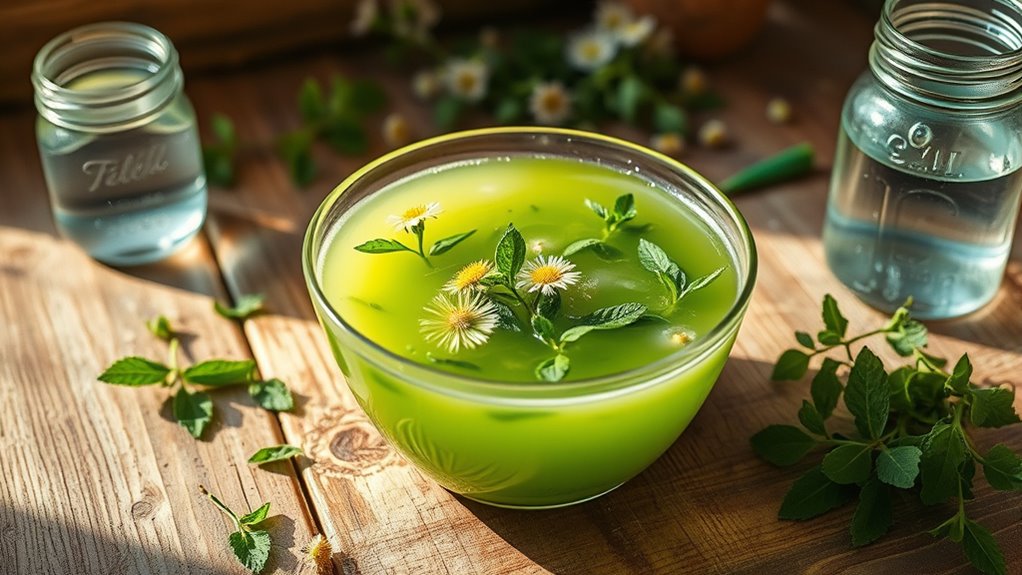If your pet needs quick rehydration, you can craft a safe herbal electrolyte broth using wild herbs like dandelion greens, nettle, and chickweed. First, gather pesticide-free herbs, wash and chop a handful, then steep in boiling water for 10-15 minutes. Strain the liquid and serve at room temperature in small amounts. This natural remedy helps restore electrolytes and hydration safely. Keep an eye on your pet’s response, and discover more ways to support their recovery.
Key Takeaways
- Collect pesticide-free wild herbs like dandelion, nettle, and chickweed from uncontaminated areas for safe herbal broth.
- Wash herbs thoroughly, chop them, and steep in boiling water for 10-15 minutes to extract natural electrolytes.
- Strain the herbal infusion to remove solids, then cool it to room temperature before offering to your pet.
- Serve small amounts using a syringe or shallow bowl, gradually increasing to support hydration and recovery.
- Avoid added salt or ingredients that may upset sensitive stomachs; monitor your pet’s response closely.

When your pet is feeling under the weather or needs extra hydration, a homemade electrolyte broth made from wild herbs can be a safe and natural solution. This approach taps into herbal foraging, allowing you to gather fresh, wild herbs that are known for their hydrating and healing properties. Using natural remedies like these provides a gentle way to support your pet’s recovery without relying on commercial products filled with preservatives or artificial ingredients.
Homemade wild herb electrolyte broth offers a gentle, natural way to hydrate and support your pet’s recovery.
The key to creating an effective electrolyte broth is selecting the right herbs. Common wild herbs such as dandelion greens, nettle, and chickweed are excellent choices because they are packed with vitamins, minerals, and natural electrolytes like potassium and magnesium. Dandelion greens, for instance, help restore electrolyte balance and support liver health, while nettle offers anti-inflammatory benefits and boosts hydration by increasing water retention in tissues. Chickweed is gentle yet nourishing, making it suitable for pets with sensitive stomachs. When foraging, always make sure you’re collecting these herbs from areas free of pesticides, pollution, or other contaminants. Proper identification is essential, so consult reliable guides or experts if you’re uncertain.
Once you’ve gathered your herbs, wash them thoroughly to remove dirt and potential toxins. To prepare the broth, steep a handful of chopped wild herbs in boiling water for about 10-15 minutes. Strain the liquid to remove plant material, ensuring the broth is clear and safe for your pet. You can enhance the broth’s flavor and nutritional profile by adding a pinch of sea salt or a small amount of honey, but only if your pet tolerates these ingredients. Be cautious with salt; use it sparingly to avoid upsetting your pet’s electrolyte balance.
Serving the broth at room temperature is best, as hot liquids can cause burns or discomfort. Offer it in small amounts, gradually increasing as your pet shows interest or improves hydration. Use a syringe or a small bowl for easier administration, especially if your pet is weak or reluctant to drink. This homemade electrolyte solution not only helps replenish lost minerals but also encourages hydration, which is essential during illness or recovery. Incorporating home remedies that are simple and natural can also help reduce reliance on commercial products and promote a more sustainable approach to pet care.
Frequently Asked Questions
Can Wild Herbs Used in the Broth Be Toxic to Pets?
You wonder if wild herbs in the broth are toxic to pets. Herb toxicity varies; some wild herbs are safe, while others can harm your pet. To guarantee pet safety, research each herb thoroughly before use. Avoid herbs known for toxicity, like foxglove or hemlock. Always consult a veterinarian if you’re unsure. Using safe, pet-friendly herbs helps prevent herb toxicity and keeps your furry friend healthy.
How Often Should I Administer Electrolyte Broth to My Pet?
Imagine your dog recovering from a bout of vomiting, desperately needing hydration. You might wonder about dosing frequency—how often to give electrolyte broth. Generally, follow your vet’s hydration schedule, offering small amounts every few hours. For mild dehydration, administering every 4-6 hours helps replenish lost electrolytes without overloading. Always monitor your pet’s response and adjust as needed, ensuring safe and effective hydration during recovery.
Are There Any Pets Allergic to Specific Wild Herbs?
Herb allergies can affect some pets, so it’s essential to verify signs like itching or swelling when introducing new herbs. Certain wild herbs might pose toxic risks, especially if your pet has sensitivities. Before giving your pet any herbal broth, research herb allergies and toxic herb risks thoroughly. Always consult your vet to ensure the herbs you choose are safe and suitable for your pet’s specific health needs.
Can This Electrolyte Broth Replace Veterinary Hydration Treatments?
Think of this electrolyte broth as a gentle lifeline, but it can’t substitute veterinary hydration treatments. While it’s a useful home remedy, especially when your pet’s lost fluids, you must guarantee herbal safety and consult your vet first. It’s like a Band-Aid for dehydration, not a cure-all. Rely on professional care for severe cases, but you can use this broth to support minor dehydration and keep your pet comfortable.
What Signs Indicate My Pet Needs Emergency Hydration Immediately?
If you notice dehydration symptoms like dry gums, lethargy, sunken eyes, or rapid breathing, it’s time for an emergency response. These signs indicate your pet needs immediate hydration support. Don’t delay—seek veterinary care right away, especially if symptoms worsen or persist. Acting quickly can prevent serious complications and ensure your pet recovers safely. Always monitor for dehydration symptoms and respond promptly to keep your pet healthy.
Conclusion
So, next time your furry friend looks like they’re auditioning for a desert survival show, whip up this herbal electrolyte broth. Who knew that wild herbs could turn your pet’s dehydration drama into a botanical spa day? Forget pricey vet visits or synthetic solutions—nature’s got your back. Just remember, if your pet starts doing a rain dance after sipping, maybe stick to the basics. Stay prepared, stay clever, and keep those tails wagging!










